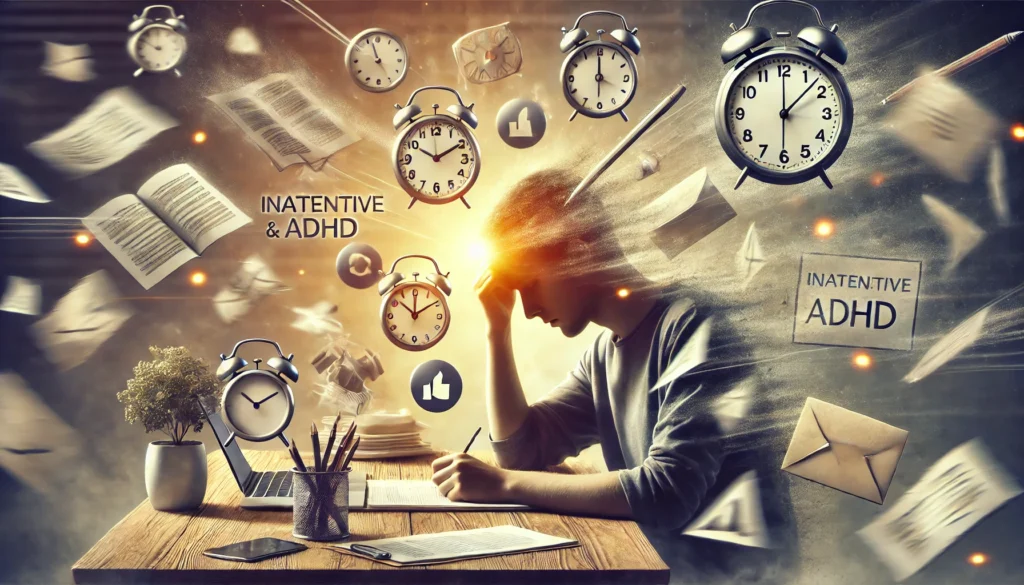In this article, we aim to demystify inattentive ADHD by exploring its symptoms, debunking common myths, and providing a comprehensive overview for those seeking to understand this condition better. By breaking down the complexities of inattentive ADHD, we hope to foster a more informed and supportive environment for individuals living with this condition.
You may also like: Enhancing Concentration: Strategies for ADHD
Understanding Inattentive ADHD
Inattentive ADHD, previously known as Attention Deficit Disorder (ADD), is characterized predominantly by a lack of focus and organizational skills without the hyperactive and impulsive behaviors often associated with ADHD. This distinction is crucial for appropriate diagnosis and management, as inattentive ADHD requires different strategies than those typically used for hyperactive or combined types of ADHD.
While it shares some commonalities with other ADHD subtypes, inattentive ADHD is distinct in its presentation, making it important to recognize its unique traits and challenges. Understanding these nuances is the first step toward effective intervention and support for individuals affected by this condition.
Core Symptoms of Inattentive ADHD
Inattentive ADHD manifests through a variety of symptoms that can differ significantly between individuals. Here’s a deeper look into these symptoms:
Difficulty Sustaining Attention
Individuals may struggle to stay focused on tasks or activities, often making careless mistakes in work or school. This can lead to frustration and a sense of inadequacy, as they may be perceived as not trying hard enough. The lack of focus is not a choice but a symptom, which requires understanding and strategic support to manage effectively.
Disorganization
Keeping track of responsibilities or managing time efficiently can be challenging. This disorganization isn’t due to lack of effort but rather a symptom of the brain’s difficulty in processing and prioritizing tasks. Strategies to improve organizational skills, such as planners or digital tools, can be beneficial.
Forgetfulness
Frequently forgetting daily activities, appointments, or necessary tasks is common. This forgetfulness can impact relationships and responsibilities, leading to misunderstandings or perceived neglect. Techniques such as reminders and habit-building can help mitigate these challenges.
Avoidance of Mental Effort
Tasks requiring sustained mental effort are often avoided. This avoidance is not due to laziness but rather a genuine difficulty in maintaining mental stamina. Breaking tasks into smaller, manageable parts can help individuals tackle challenging activities without feeling overwhelmed.
Frequent Daydreaming
Inattentive individuals may appear to be in a dreamlike state, detached from their surroundings. This daydreaming can be misconstrued as disinterest or lack of intelligence, but it is a symptom of inattentive ADHD. Encouraging active engagement through interactive tasks can help redirect focus.
Debunking Common Myths
Despite its prevalence, inattentive ADHD is often misunderstood. Here, we dispel some of the most pervasive myths associated with the condition.
Myth 1: ADHD is Only About Hyperactivity
A prevalent myth is that ADHD solely involves hyperactivity. Inattentive ADHD debunks this notion, as individuals with this subtype often lack the impulsive or hyperactive symptoms associated with other forms of ADHD. Instead, their challenges revolve around focus, organization, and memory. Understanding this distinction is crucial for recognizing inattentive ADHD and providing appropriate support.
Myth 2: Only Children Can Have ADHD
ADHD is often thought of as a childhood condition. However, adult ADHD is a well-recognized phenomenon, with many adults only receiving a diagnosis later in life. Symptoms in adults can manifest as difficulty in managing time, disorganization, and issues with employment or relationships. Raising awareness about adult ADHD is essential for ensuring those affected receive the support they need at any age.
Myth 3: ADHD is Just Laziness
ADHD is a neurodevelopmental disorder and not a matter of laziness or lack of willpower. The challenges faced by those with inattentive ADHD are rooted in brain chemistry and structure, requiring understanding and appropriate interventions. Recognizing ADHD as a medical condition helps dismantle the stigma and encourages a more compassionate approach.
Myth 4: Medication is the Only Solution
Another misconception is that medication is the only way to manage ADHD. While medication can be effective, it is not the sole solution. Behavioral therapies, lifestyle changes, and supportive environments also play significant roles in managing symptoms and improving quality of life for individuals with inattentive ADHD.
Myth 5: ADHD is Overdiagnosed
Some believe ADHD is overdiagnosed, attributing normal childhood behaviors to the disorder. However, inattentive ADHD is often underdiagnosed because its symptoms are less visible than hyperactive behaviors. Ensuring accurate diagnosis requires a comprehensive understanding of ADHD’s various presentations.

Recognizing Symptoms Across Age Groups
The manifestation of inattentive ADHD symptoms can vary significantly depending on age, making it crucial to recognize how it appears in different life stages. Each stage of life brings unique challenges and adaptations for individuals with inattentive ADHD.
ADHD in Young Children
In younger children, signs of inattentive ADHD may include:
Frequent Daydreaming
Appearing disconnected from their environment, young children may seem lost in their thoughts rather than engaged in activities. This can be mistaken for a lack of interest or motivation. Providing structured activities and routines can help maintain their focus.
Easily Distracted
Moving from one activity to another without completing tasks is common. This distractibility is not intentional but a symptom of the disorder. Creating a distraction-free environment can assist in keeping children engaged and on task.
Trouble Following Instructions
Difficulty in following multi-step directions can lead to frustration for both children and caregivers. Simplifying instructions and providing visual aids can help children better understand and complete tasks.
ADHD in Teens
Teenagers with inattentive ADHD might struggle with:
Time Management
Difficulty keeping up with school assignments or activities can lead to academic challenges. Teaching time management skills and utilizing tools like planners can support teens in managing their responsibilities more effectively.
Forgetfulness
Frequently losing personal items like phones or books can be a daily occurrence. Implementing organizational strategies, such as designated places for items, can reduce forgetfulness and associated stress.
Social Challenges
Struggles in maintaining friendships due to missed cues or inattentiveness can impact social life. Encouraging open communication and social skills training can help teens build and maintain relationships.
ADHD in Adults
Adult manifestations of inattentive ADHD can include:
Career Challenges
Trouble meeting deadlines or managing workloads can affect professional success. Adults can benefit from workplace accommodations and strategies to prioritize and complete tasks efficiently.
Relationship Strain
Difficulty in listening to partners or following through on promises can create tension in relationships. Couples therapy and clear communication strategies can improve relationship dynamics.
Chronic Disorganization
A perpetually cluttered environment and chaotic schedules can lead to stress and decreased productivity. Developing organizational systems and routines can help manage disorganization and enhance daily functioning.
Diagnosis and Misdiagnosis
Diagnosing inattentive ADHD involves a comprehensive evaluation by a mental health professional. The assessment often includes a detailed history, observation, and standardized questionnaires. Accurate diagnosis is vital for effective management and support.
Risks of Misdiagnosis
Inattentive ADHD can be easily overlooked or misdiagnosed due to its subtle presentation. It is often mistaken for mood disorders, anxiety, or learning disabilities. This misdiagnosis can lead to inappropriate treatments that fail to address the root issues. Ensuring thorough evaluations and considering all possible symptoms can help achieve an accurate diagnosis.
Importance of Professional Evaluation
Professional evaluation is critical for distinguishing inattentive ADHD from other conditions with overlapping symptoms. Mental health professionals can use a variety of tools and techniques to assess the presence of ADHD and rule out other potential causes for the symptoms observed.
Role of Self-Advocacy
Individuals and families must advocate for comprehensive evaluations when inattentive ADHD is suspected. Being informed about the condition and clearly communicating symptoms can aid professionals in making accurate diagnoses and developing effective treatment plans.

Moving Forward: Management and Support
Managing inattentive ADHD requires a multifaceted approach that may include medication, behavioral therapy, and lifestyle adjustments. Each of these components plays a role in supporting individuals to live fulfilling and productive lives.
Medication and Therapy
Stimulant and non-stimulant medications can help manage symptoms, alongside behavioral therapies that focus on developing organizational skills and coping strategies. Combining medication with therapy often provides the most effective results, as it addresses both biological and behavioral aspects of ADHD.
Types of Medication
Stimulant medications, such as methylphenidate, are commonly prescribed and can improve focus and attention. Non-stimulant options, like atomoxetine, are available for those who may not respond well to stimulants. It’s important to work closely with a healthcare provider to find the right medication and dosage.
Behavioral Therapy
Therapies that focus on behavior modification can teach individuals strategies to manage symptoms. Cognitive-behavioral therapy (CBT) is particularly effective in helping individuals develop skills to organize, plan, and maintain focus on tasks.
Lifestyle Modifications
For many, lifestyle changes can significantly impact symptom management. These modifications can enhance daily functioning and improve quality of life.
Structured Routines
Establishing consistent daily routines can aid in organization and time management. Predictable schedules help reduce anxiety and provide a framework for managing tasks and responsibilities.
Mindfulness Practices
Techniques such as meditation can enhance focus and reduce stress. Mindfulness practices encourage present-moment awareness, which can help individuals manage distractions and improve concentration.
Physical Activity
Regular exercise can improve concentration and overall well-being. Physical activity stimulates the brain and can reduce symptoms of inattentive ADHD, making it a valuable component of a comprehensive management plan.
Support Systems
Building a strong support system is crucial for managing inattentive ADHD. Support from family, friends, educators, and mental health professionals can provide the encouragement and resources necessary for success.
Educational Support
Teachers and school counselors can provide accommodations and support for students with inattentive ADHD. Individualized Education Programs (IEPs) and 504 Plans can ensure students receive the assistance they need to thrive academically.
Community Resources
Engaging with community resources, such as support groups or workshops, can offer valuable insights and shared experiences. These resources provide a sense of community and understanding for individuals and families affected by inattentive ADHD.

Concluding Thoughts
Inattentive ADHD is a complex and often misunderstood condition. By dispelling myths and understanding its unique presentation across different age groups, we can foster a more inclusive and supportive environment for those affected. Whether through medication, therapy, or lifestyle changes, individuals with inattentive ADHD can lead fulfilling, productive lives with the right support and understanding.
As we continue to learn more about ADHD, we must remain open to evolving perspectives and approaches, ensuring that those with inattentive ADHD receive the recognition and care they deserve. By increasing awareness and fostering empathy, we can create a world where individuals with inattentive ADHD are empowered to reach their full potential.
Further Reading:
Attention deficit hyperactivity disorder predominantly inattentive
What Is Inattentive ADHD? Symptoms, Characteristics, Diagnostic Considerations
Attention-Deficit / Hyperactivity Disorder (ADHD)
Important Note: The information contained in this article is for general informational purposes only, and should not be construed as health or medical advice, nor is it intended to diagnose, prevent, treat, or cure any disease or health condition. Before embarking on any diet, fitness regimen, or program of nutritional supplementation, it is advisable to consult your healthcare professional in order to determine its safety and probable efficacy in terms of your individual state of health.
Regarding Nutritional Supplements Or Other Non-Prescription Health Products: If any nutritional supplements or other non-prescription health products are mentioned in the foregoing article, any claims or statements made about them have not been evaluated by the U.S. Food and Drug Administration, and such nutritional supplements or other health products are not intended to diagnose, treat, cure, or prevent any disease.


